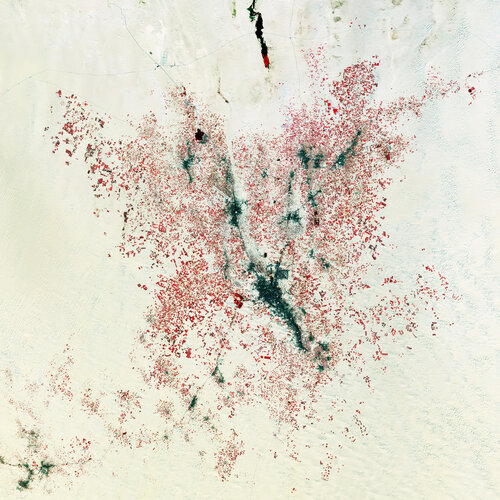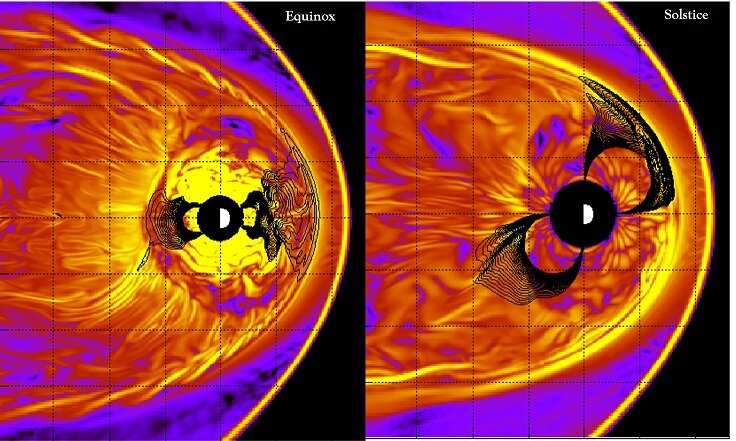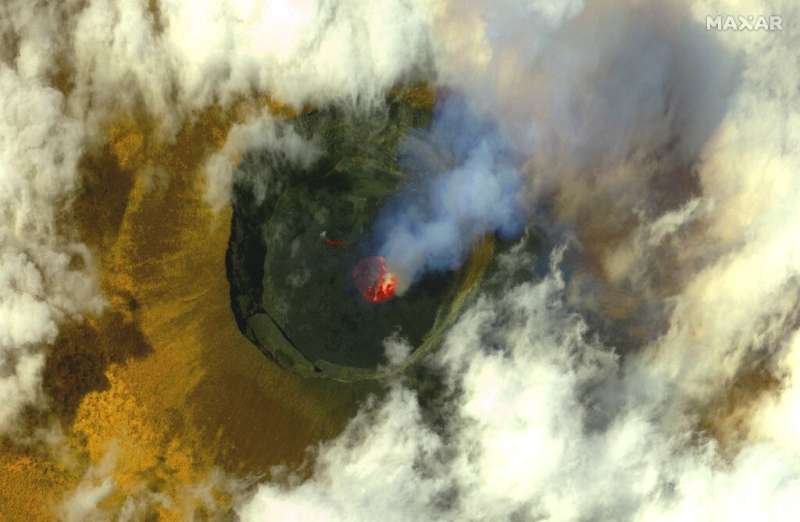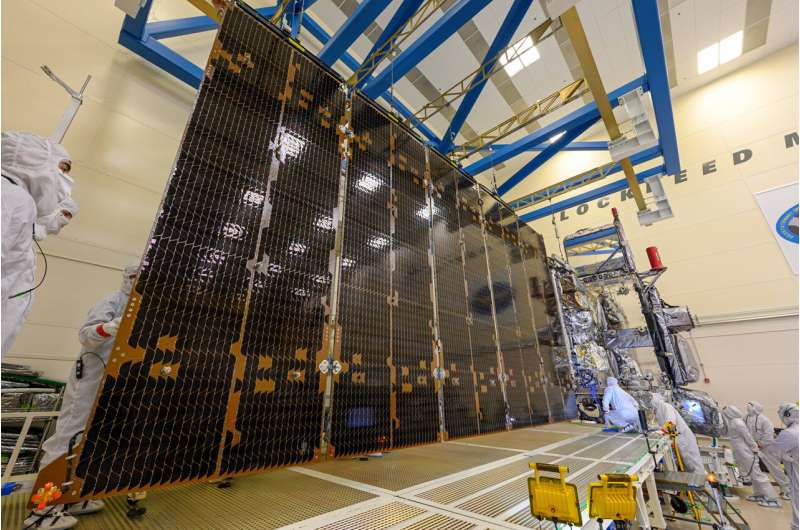
Copernical Team
Neutron star's X-rays reveal 'photon metamorphosis'
 A "beautiful effect" predicted by quantum electrodynamics (QED) can explain the puzzling first observations of polarized X-rays emitted by a magnetar - a neutron star featuring a powerful magnetic field, according to a Cornell astrophysicist.
The extremely dense and hot remnant of a massive star, boasting a magnetic field 100 trillion times stronger than Earth's, was expected to generate h
A "beautiful effect" predicted by quantum electrodynamics (QED) can explain the puzzling first observations of polarized X-rays emitted by a magnetar - a neutron star featuring a powerful magnetic field, according to a Cornell astrophysicist.
The extremely dense and hot remnant of a massive star, boasting a magnetic field 100 trillion times stronger than Earth's, was expected to generate h Cosmonauts transfer airlock between ISS modules
 Russian Roscosmos cosmonauts, Sergey Prokopyev and Dmitri Petelin completed a spacewalk Wednesday to transfer an equipment airlock from one module of the International Space Station to another.
While Prokopyev and Petelin were outside assisting, a third cosmonaut, Andrey Fedyaev, stayed inside the station to operate the European Robotic Arm to move the airlock from the station's Rassvet
Russian Roscosmos cosmonauts, Sergey Prokopyev and Dmitri Petelin completed a spacewalk Wednesday to transfer an equipment airlock from one module of the International Space Station to another.
While Prokopyev and Petelin were outside assisting, a third cosmonaut, Andrey Fedyaev, stayed inside the station to operate the European Robotic Arm to move the airlock from the station's Rassvet SpaceX lifts another 56 Starlink satellites into lower Earth orbit
 SpaceX carried another 56 Starlink Internet satellites into space from the Cape Canaveral Space Station on Thursday morning, its 27th orbital mission on its workhorse Falcon 9 rocket this year.
The satellites released into lower Earth orbit on Thursday will enable Internet users around the world to connect online to remote and far-flung regions of Earth. For SpaceX, the successful launc
SpaceX carried another 56 Starlink Internet satellites into space from the Cape Canaveral Space Station on Thursday morning, its 27th orbital mission on its workhorse Falcon 9 rocket this year.
The satellites released into lower Earth orbit on Thursday will enable Internet users around the world to connect online to remote and far-flung regions of Earth. For SpaceX, the successful launc The mysterious origins of Martian meteorites
 In August 1865, a 10-pound rock fell from space to Earth, landing with a bang in the remote village of Sherghati, India. After being recovered by witnesses to the event, the stone passed into the possession of a local British magistrate who endeavored to identify the source of the strange object. After more than a century of studying the meteorite fragments-so-called shergottites-researchers in
In August 1865, a 10-pound rock fell from space to Earth, landing with a bang in the remote village of Sherghati, India. After being recovered by witnesses to the event, the stone passed into the possession of a local British magistrate who endeavored to identify the source of the strange object. After more than a century of studying the meteorite fragments-so-called shergottites-researchers in The Moon's heart revealed for the first time
 Half a century after Apollo 11 initiated the first lunar surveys, a collaborative team of scientists from CNRS, University of the Cote d'Azur, Cote d'Azur Observatory, Sorbonne University, and Paris Observatory-PSL has unveiled a previously unknown aspect of the Moon's internal structure: a solid core akin to Earth's. Alongside this groundbreaking discovery, the researchers also provide evidence
Half a century after Apollo 11 initiated the first lunar surveys, a collaborative team of scientists from CNRS, University of the Cote d'Azur, Cote d'Azur Observatory, Sorbonne University, and Paris Observatory-PSL has unveiled a previously unknown aspect of the Moon's internal structure: a solid core akin to Earth's. Alongside this groundbreaking discovery, the researchers also provide evidence Earth from Space: Farming the desert
 Image:
The Copernicus Sentinel-2 mission takes us over El Oued, in northeast Algeria, about 80 km west of the border with Tunisia.
Image:
The Copernicus Sentinel-2 mission takes us over El Oued, in northeast Algeria, about 80 km west of the border with Tunisia. 'Space waves' offer new clues to space weather

More accurate space-weather predictions and safer satellite navigation through radiation belts could someday result from new insights into "space waves," researchers at Embry-Riddle Aeronautical University reported.
The group's latest research, published on May 4, 2023, by the journal Nature Communications, shows that seasonal and daily variations in the Earth's magnetic tilt, toward or away from the sun, can trigger changes in large-wavelength space waves.
Africa eyes potential bounty from space

After decades on the sidelines, African countries are venturing into the space industry, hoping to reap rewards in agriculture, disaster prevention and security.
Ivory Coast, which recently hosted a "NewSpace Africa" conference organized by the African Union, has announced the creation of a space agency and plans to build the country's first nanosatellite by 2024.
In April, Kenya's first working satellite was put into orbit by a SpaceX rocket launched from the United States.
The two countries follow African pioneers South Africa, Nigeria, Algeria and Egypt—a trailblazer which owned the first African satellite sent into space in 1998.
Prep in the pool for Europe's next astronauts

A new cohort of astronauts at the European Space Agency's training center in Cologne, Germany, can expect to see time in both the pool and the classroom as they get ready to head into orbit.
Trainees dive into the water to emulate the experience of working in zero gravity, as well as studying a variety of subjects from medicine to geology.
The aim of the curriculum is to prepare the group for service on the International Space Station (ISS) and later on a potential mission to the moon.
"The biggest challenge is to learn so many different things in a very short period of time," British astronaut Rosemary Coogan, 31, told AFP in an interview.
NOAA's GOES-U satellite completes solar array deployment test

GOES-U, the fourth and final satellite in NOAA's GOES-R Series, recently completed a successful test deployment of its solar array to ensure it will function properly in space.
This critical test verified that the satellite's large, five-panel solar array—which is folded up when the satellite is launched—will properly deploy when GOES-U reaches geostationary orbit. During this test, engineers unfurled the five panels on rails that simulated the zero-gravity environment of space. Each solar panel is approximately 13 feet tall by 4.5 feet wide and weighs approximately 45 pounds.
Once GOES-U reaches orbit, the deployed solar panels will form a single solar array wing that will rotate once per day to continuously point its photovoltaic (solar) cells toward the sun. The photovoltaic cells will convert energy from the sun into electricity to power the entire satellite, including the instruments, computers, data processors, sensors, and telecommunications equipment. The solar array will generate more than 5,000 watts of power for the satellite. This is equivalent to the power needed to run a central air conditioning system in your home.

